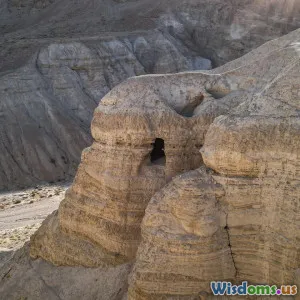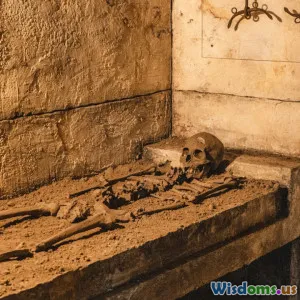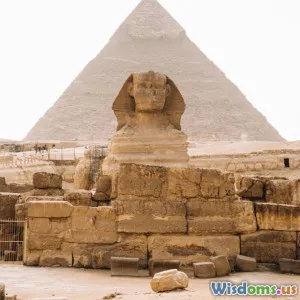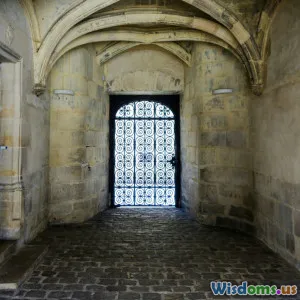
What The Vatican Hid About The Dead Sea Scrolls
11 min read Explore the Vatican's controversial role in the hidden truths and mysteries surrounding the Dead Sea Scrolls discovery. (0 Reviews)
What The Vatican Hid About The Dead Sea Scrolls
Introduction: Unveiling Ancient Secrets Hidden in Plain Sight
When the Dead Sea Scrolls were discovered in the mid-20th century, the world stood at the precipice of an archaeological breakthrough unlike anything before. These ancient manuscripts, dating back over two millennia, contain some of the oldest known texts of the Hebrew Bible and Jewish sectarian writings, reshaping our understanding of religious history. Yet, amid the excitement, a shadow loomed over this discovery: the Vatican's secretive role and limited access to these powerful documents. What did the Vatican truly conceal about the Dead Sea Scrolls, and why has the Catholic Church been so cautious—even reticent—about releasing and interpreting them?
This article delves deep into the multifaceted relationship between the Vatican and the Dead Sea Scrolls, exploring the historical, theological, and political ramifications of the Church’s control over these ancient texts.
1. The Discovery and Initial Control of The Dead Sea Scrolls
A Discovery That Shook Biblical Archaeology
In 1947, a young Bedouin shepherd stumbled upon a series of caves near the ancient site of Qumran by the Dead Sea, discovering a trove of scrolls and fragments. These manuscripts dated from roughly 150 BCE to 70 CE and included some of the oldest surviving copies of the Old Testament, along with texts related to the Jewish sect conventionally identified with the Essenes.
However, the discovery quickly turned contentious. The scrolls were initially taken into the possession of a tight committee of scholars—predominantly Western, many with connections to the Vatican and other religious institutions.
Vatican’s Influence in Early Scholarship
The Vatican has a long history of centralized control over biblical scholarship to maintain doctrinal consistency. When it came to the Dead Sea Scrolls, this role became even more pronounced. The Vatican’s representatives insisted on a cautious, sometimes restrictive, approach to publishing the scrolls. This vigilance was partly rooted in a desire to mediate any apparent contradictions these manuscripts might present to the Church’s established biblical canon and teachings.
The Vatican was not alone but arguably the most powerful force urging restraint. This resulted in a slow, painstaking, and highly controlled process of cataloging and publishing many scroll fragments; certain portions only became widely available many decades after their discovery.
2. Why Did the Vatican Conceal the Scrolls’ Contents?
Conflicting Narratives and Theological Challenges
The Dead Sea Scrolls contain variant biblical texts that sometimes contradict the Latin Vulgate and the Masoretic Text—the traditional Hebrew Bible serving as the foundation for most Christian Old Testaments. These discrepancies presented a potential theological challenge for the Catholic Church, which holds the canonical scriptures in sacred authority.
One critical example lies in the text of Isaiah 53, which Christians interpret as a prophecy about Jesus as the suffering Messiah. The scrolls’ versions, however, have subtle but meaningful variations that raised questions about interpretive traditions.
Protecting Orthodoxy through Control
The cautious approach to sharing the scrolls may reflect a Vatican strategy to tightly manage potential doctrinal disruptions, allowing Church scholars to frame interpretations before the broader public and academic community could investigate freely. This control also helped mitigate any internal disputes within Catholic theological circles and between other Christian denominations regarding scriptural authenticity.
Quotes from Church officials, such as Cardinal Jean Daniélou who once called for “prudence,” underscore the desire to avoid hasty conclusions that might destabilize core scriptural doctrines.
3. The Secrecy and Delays in Publishing the Scrolls
Restricted Access for Decades
Despite the momentum generated by the scrolls' discovery, it was reported for years that many fragments were kept off-limits to independent or non-Catholic scholars. For instance, the international Dead Sea Scrolls team, responsible for painstakingly reconstructing, translating, and analyzing the thousands of fragments, was a small, tightly-knit group, many appointed by teams with Vatican links.
Only a handful of members had permission to view and study the scrolls at any given time, a policy that came under increasing criticism from the academic community. Scholars outside this privileged circle complained of inaccessibility and a monopolized control of knowledge.
The 1991 Publication Breakthrough
It wasn't until 1991 that a partial breakthrough occurred when the Huntington Library published photographs of many previously unseen scroll fragments. This democratization of access came after persistent pressure from scholars demanding transparency. Yet, even then, some fragments were allegedly withheld or delayed due to sensitive content.
4. What Did the Vatican’s Hidden Scrolls Reveal—Or Conceal?
Doctrinal Dissonance
One controversial aspect the Vatican appeared to silence relates to scrolls that describe messianic concepts differing from Christianity’s prevailing view. The scrolls often depict multiple messianic figures, including a prophet-priest and a kingly Messiah, complicating a straightforward Christological reading.
Moreover, the scrolls include apocalyptic visions and regulations that present radical sectarian views on purity, law, and community structure—elements that suggest sectarian Judaism inside Palestine was far more diverse and fragmented than the Church traditionally acknowledged.
Political and Religious Implications
The scrolls’ contents also emphasize a Jewish community struggling under Roman imperial occupation, with themes of rebellion and divine justice. Accepting and openly discussing such evidence could conflict with the historical narrative that Christianity emerged peacefully and exclusively as a fulfilled messianic faith.
The Vatican’s guarded stance, many scholars argue, can be interpreted as an effort to prevent questions that might destabilize Christian claims or reduce early Christianity’s distinctiveness away from a Jewish context.
Interestingly, former Vatican insiders have hinted that some documents remain classified because of their perceived potential to radicalize theological debates.
5. The Vatican’s Modern Approach and Emerging Transparency
Gradual Declassification and Digital Age Progress
In the 21st century, the Vatican has taken incremental steps toward increased accessibility, cooperating with archaeologists and researchers worldwide. The digitization of the Dead Sea Scrolls by institutions such as the Israel Antiquities Authority and their public release have pressured the Vatican to embrace more transparency.
Moreover, Papal statements encourage scholarly inquiry, reflecting the Church’s broader engagement with historical criticism and dialogue between science and faith.
Lessons from Secrecy
The history of concealed Dead Sea Scrolls teaches a crucial lesson about the intersection of faith, power, and the ownership of knowledge. When religious institutions control access to foundational documents, truths may be obscured, delaying humanity’s understanding of its shared past.
The Vatican’s evolving stance highlights a move toward fostering an open-minded environment where faith and historical scholarship can coexist without fear.
Conclusion: The Dead Sea Scrolls as a Catalyst for Faith and Inquiry
The Vatican’s hidden role in handling the Dead Sea Scrolls underscores a story beyond mere documents—it’s about control, ideology, and the human quest for truth. While secrecy and delays provoked frustration and conspiracy theories, they also sparked an important dialogue about transparency and inclusivity in religious scholarship.
As more scrolls enter public discourse, scholars and believers alike are invited to revisit ancient texts with fresh perspectives that both challenge and enrich our understanding of religious origins.
The Dead Sea Scrolls remain a testament not only to an ancient Jewish sect’s hopes and fears but also to the complex interplay between religion, power, and knowledge—even at the highest levels of ecclesiastical authority.
For any curious mind, the ongoing story of the Dead Sea Scrolls—and the Vatican’s part in it—remains a fertile ground for exploration, reflection, and possibly, revelation.
References
- Vermes, Geza. The Complete Dead Sea Scrolls in English. Penguin Books, 2012.
- Charlesworth, James H. (Ed.). The Dead Sea Scrolls. Fortress Press, 1992.
- Schiffman, Lawrence H. Reclaiming the Dead Sea Scrolls. Jewish Publication Society, 1994.
- Fitzmyer, Joseph A. The Dead Sea Scrolls and Christian Origins. Eerdmans, 2008.
- Betz, Hans Dieter. The Scrolls and the New Testament. Fortress Press, 1993.
- Vatican archives and statements relating to biblical scholarship (1990-2020).
Rate the Post
User Reviews
Popular Posts



















